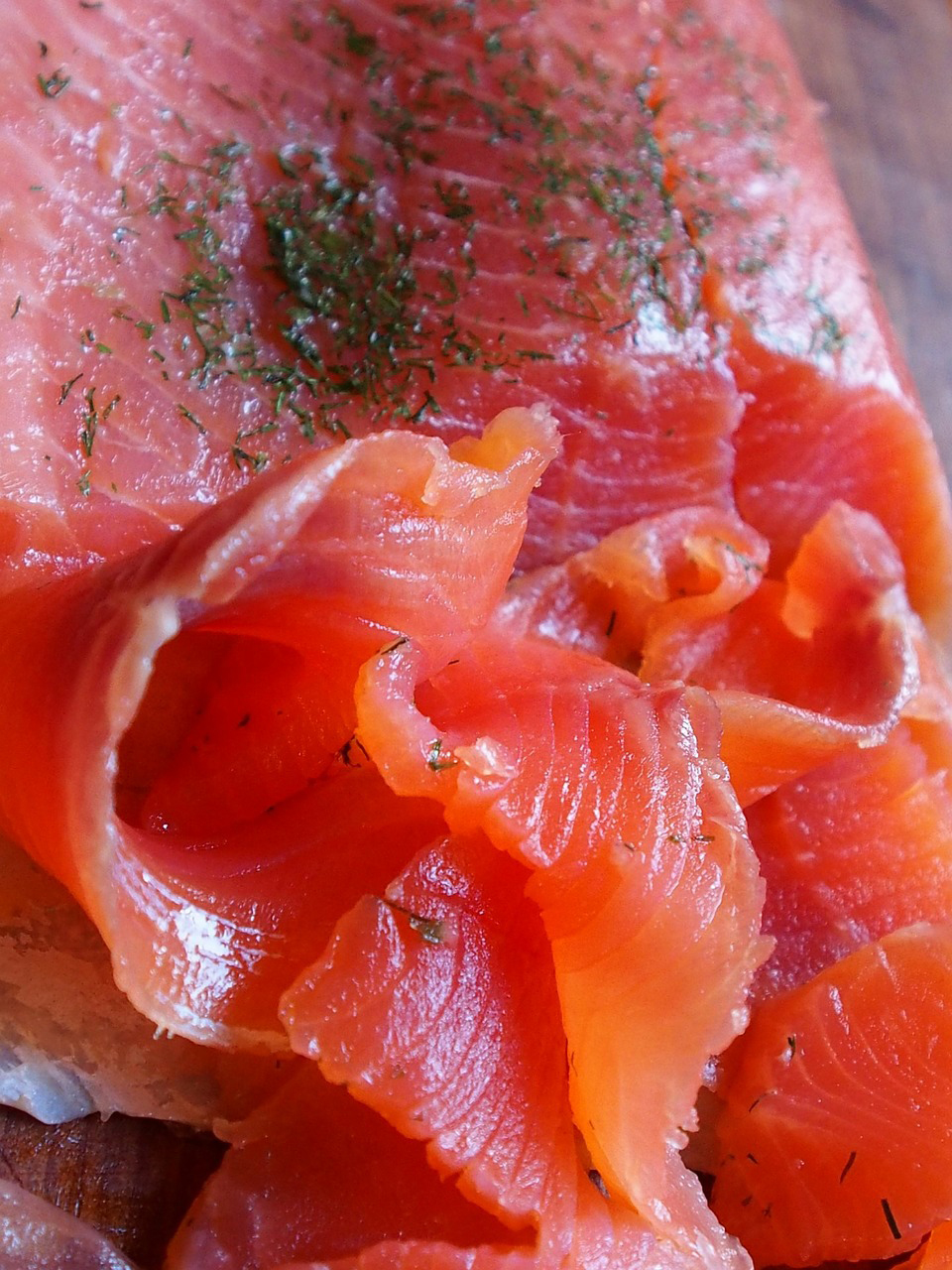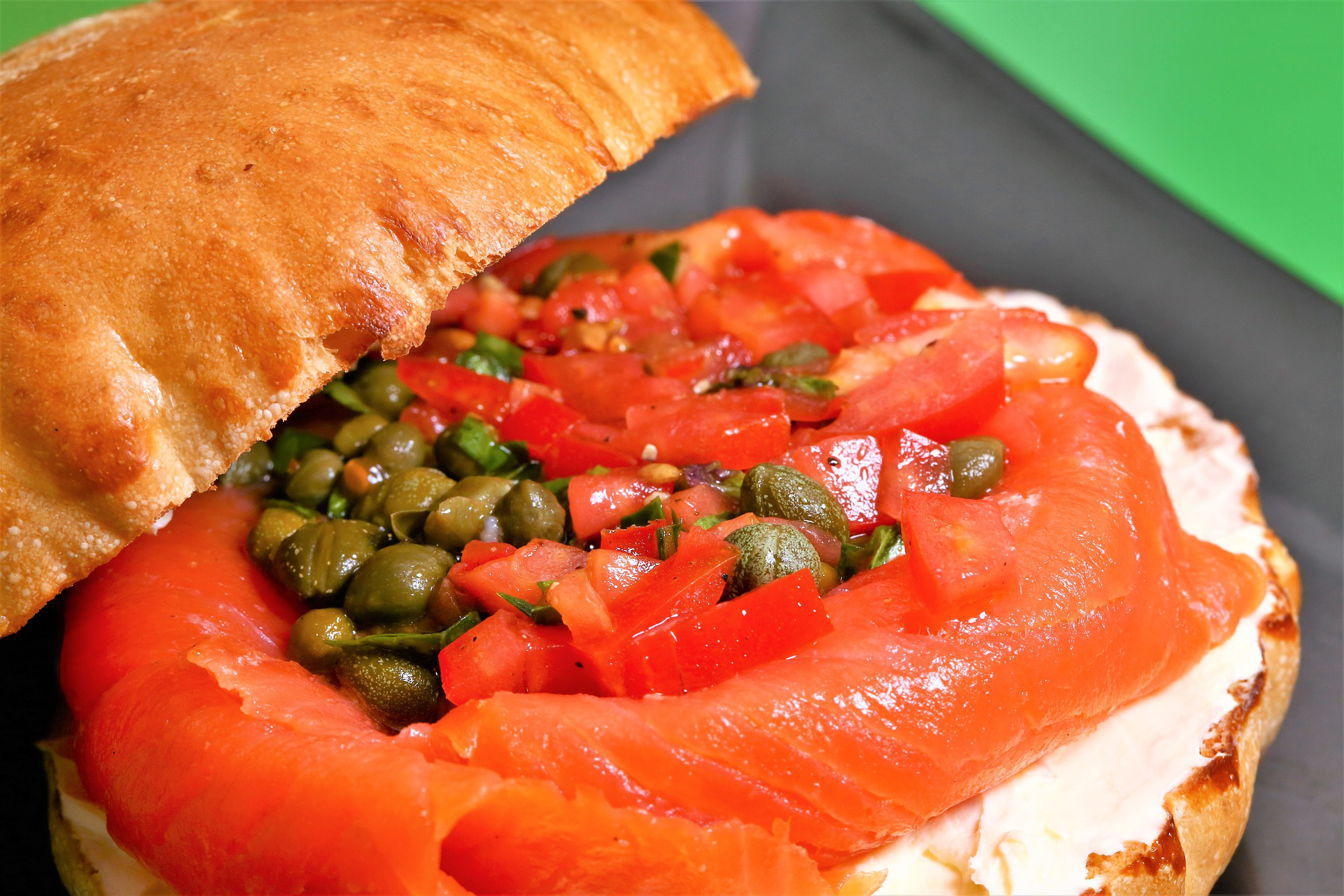CIRCLE OF LIFE
Bagels and Lox: The Quintessential Brunch of New York City

Bagels ’n Lox. The simplest of NYC’s classic brunches. A proper bagel – fresh-crusted and densely chewy – halved through its waistline, with the cut surface of each ring thickly schmeared in soft cream cheese and topped by translucent ribbons of cured salmon. A New York icon. Lox? That’s salmon.
This is a genuine silver-bullet against what lurks in the darkest clutches of the Morning After. On the really brightening side, there’s nothing to cook and very little to prepare. It certainly checks some must-have boxes.
It might not be strictly traditional, but some grand additions are little slivers of mild red onion, a fine slice of tomato and a few tart, diced-up capers. I prefer mine “open’”with the two bagel halves loaded separately and dressed with a tiny squeeze of lemon juice and then a grind or two of black pepper.
Toasted bagels? Bagels should be fresh. If they’re not, you will have to toast them… lightly.
Fish, bread, spread. The Trinity Slowly Comes Together. A Three-Part Story
For the sky-rocketing numbers of home-country oppressed, often cash-strapped Jews emigrating from Europe and Russia and settling mainly in Manhattan’s Lower East Side during the 1880s and onwards, there was an open sandwich that pressed the right buttons.
It was good, it was cheap and it was convenient in the sense that it didn’t need to be cooked or plated. The foundation for what eventually became Bagels ‘n Lox was typically a slice of dark rye bread with a spread (a schmear) of schmaltz (usually clarified chicken fat), or maybe butter, topped off with thin slices of economical pickled herring rather than pricey salmon. It was traditional fare from the “old countries”.
But it wasn’t until the mid-1920s – when the more affluent, second “making-it-in-America generation” of Jewish Lower East Siders had blossomed – that this fish, bread and spread combo morphed into what we now know as Bagels ’n Lox. Here’s how it probably happened.
First: Around Comes the Bagel

Photo by Christine Siracusa on Unsplash
No question, New York’s signature bread is the bagel. Having crossed the Atlantic with immigrant Jewish bakers, it established its headquarters on the Lower East Side.
But it was nothing like the bagels we know today. Oh, no. It was more like a large, circular pretzel with a hole big enough to put your hand through – a sort of “biscuit bracelet” – rather than a softish bun with a little middle hole. It was eaten in broken-off pieces that you’d dip into schmaltz or butter rather than being cut and spread with anything. And just like a biscuit, it was longer lasting and far less prone to going stale.
This traditional bagel began evolving in NYC from around 1895 through to the mid-1920s by when it had become plumper, like a doughnut, smaller (maybe two-thirds the size of today’s bagels), had a hole of about 1.5cms and was soft enough to be cut. At last it was a bread for spread.
But it was still a bit of a hard-chewing mouthful. Its transition to the still-softer modern bagel was probably almost complete by the late 1950s but it didn’t become the “standard” textured bagel of today until after 1963 and the introduction of a super-efficient, California-invented, market-dominating, bagel-making machine.
Making those pretzel-like bagels back in the late 1800s and early 1900s wasn’t a job for the faint-hearted. Things were so horrendously bad in the bagel baking game that about 300 workers formed “The International Beigel Bakers Union New York” in 1907.
It was a tough, Jewish, male-only, strictly Yiddish-speaking outfit whose main purpose was to improve the hellish working conditions and low wages of bagel makers slaving away in tenement basements on the Lower East Side.
These were seriously bad cave-like places with no ventilation for the elementary solid fuel ovens and boiling pots. In her book, The Bagel – The Surprising History of a Modest Bread, Maria Balinska says:
“Bakers worked shirtless stripped to their waist for thirteen or fourteen hours a day, seven days a week. Typically young and unmarried, they often lived at their workplace sleeping between the mounds of rising dough and the oven with cats, rats and ‘cockroaches as big as birds’ for company. Illness was common and lifespan short.”
And everything was done by hand – dough making, kneading, rolling, forming, boiling, baking and stringing together for wholesale selling.
A 2003 article in The New York Times says they were made of “high-gluten flour, water, yeast, salt and malt syrup, mixed together in a hopper. Rollers would then take two-inch strips of dough and shape them. A designated bagel boiler would boil the bagels in an industrial kettle for less than a minute, which gave the bagel its tight skin and eventual shine. Finally, a third bagel man would put the bagels on thick redwood slats covered with burlap and place them in a brick or stone-lined oven.”
Those early, hard-nut unionists gradually came to dominate and ameliorate the NYC bagel industry. In 1937 the union consolidated its NYC and New Jersey power base into a new union, ‘Bagel Bakers Local 338’. By the early 1940s its negotiating muscle meant bagel-men were earning more than most city high-school teachers.
Their product was still fully handmade, but they now worked a 37-hour week in clean, modern environments, overtime was voluntary, and benefits included healthcare, paid holidays and 24 free bagels for each day worked. They were styling – and possibly a bit portly….
Their rise from the bagel basements came about because the bagel business was big business. New Yorkers’ hunger for bagels was astonishing. A 1960 NY Times article reckoned that 250,000 handmade bagels were being baked in the city every day. If it was every day, that works out to over nine million fresh bagels a year for a city population that was then around eight million. NYC’s signature bread? Ya betta believe it.
Second: In leaps the salmon

Image by PublicDomainPictures from Pixabay
Topping NYC’s list of traditional fish-for-bagels is Lox – salmon. The word comes from the German “lachs” and the Yiddish “laks” – and it’s not smoked.
Sliced more thickly than its smoked alternative, real (“authentic”, if you must…) lox is from the intensely rich, fat-striped belly of Pacific salmon that have been preserved in heavily salted brine for perhaps half a year or more.
Before the convenience of effective canning and refrigeration, salting or “hard curing” was the way to preserve salmon. It was put to good use during the industrialised salmon bonanza on the Columbia River in the American West that began in the late 1850s. (In those days on the Columbia, a pioneering Scottish sea captain got into the salmon business and the firm he started bears his name to this day: John West. A canny Scot indeed…).
“Hard-curing” required packing layers of freshly caught, cleaned salmon into a tank with a scattering of salt between each layer. About 1.2 kg of salt was used for every 10 kg of salmon. The tank was “sealed” with a covering brine of about 25% salt and left for maybe a week. The salmon was then tightly packed into 200-pound wooden barrels topped with fresh brine. Lox and lox of salt…
Although the canning of Pacific salmon (mainly for export to Europe) was far more common by the late 1870s, salting in barrels still continued – especially when the canneries and the newer refrigeration plants faced an over-supply of seemingly never-ending fish. With the completion in 1888 of the Northern Pacific Railway’s transcontinental line, salted Columbia salmon could be freighted to New York fishmongers.
The most common of the Pacific salmon barrelling into New York were chinook or king salmon. Their large size – the biggest of all salmon – meant they were the fish best suited to the hard-curing, barrel-packing process. Before being offered for sale to customers, they had to be thoroughly washed and soaked in water to drop the astronomical salt content of the flesh. Even then, it tasted really salty.
“That term ‘bagel and lox’ started with belly lox. It’s so salty it needed the cream cheese to cut the salinity.”
That’s the definitely-to-be-respected opinion of Niki Russ Federman from New York’s ultra-famous Russ & Daughters. This cured-fish focused store was opened on the Lower East Side in 1914 by her great-great-grandparents, the husband-and-wife team of Joel and Bella Russ. Some years previously, the enterprising couple had started out in the fish business with a pushcart selling traditional, eastern European-style pickled herring.
“Russ & Daughters occupies that rare and tiny place on the mountain top reserved for those who are not just the eldest and the last – but the best,” said Anthony Bourdain.
As refrigeration for initial storage and railroad shipping became increasingly inexpensive in the early 1900s, a new way to preserve and ship the abundant Pacific salmon was developed. It could be much more lightly brined, then deeply chilled on site in huge casks containing around 350 kilos of salmon ready for shipping on the railroads’ fast-developing “cold chain”. On arrival in NYC, it could be quickly rinsed – as opposed to washed and soaked – and then rapidly smoked to complete its preservation. By rapid, I mean a smoking process that could be completed in as little as four hours.
Lox’s popularity really started to fade in the late 1930s. The advent of large-scale refrigeration replaced the preserving necessity of heavy salting and wooden barrels. As with so many mass-marketed foods, commercially-compelling convenience conquered conventional tastes.
And that, really, was the death knell for lox. And the booming beginning of NYC smoked salmon.
Smoked Salmon in New York: Nova and Gaspe
Q: “How do you keep your bagel from being stolen?” A: “Put lox on it.”
At Russ & Daughters if a customer asks for lox, they apparently get asked, “Are you sure?”
Although it may be hyper-traditional, intensely salty lox has been totally pushed aside by the milder taste of lightly-salted and then lightly-smoked salmon.
It’s the wood smoking that creates the firm, silky texture that allows the flesh to be more easily sliced into those thinly translucent ribbons heading for your bagel. It also imparts that distinctive, er, smoked flavour.
In NYC, smoked salmon is also often referred to as Nova and sometimes as Nova Gaspe. The names hark back to a time when once-plentiful wild Atlantic salmon were caught in Nova Scotia and the Gaspe Peninsula of Quebec.
Due to massive over-exploitation of Atlantic salmon, the terms Nova and Gaspe now simply refer to smoked salmon. The chances of it being from a wild Atlantic fish are extremely remote. Far more likely it will be from a fatter, richer-tasting salmon reared in the much less demandingly exertive caged waters of a big Atlantic salmon farm off the coast of Chile, Norway, Canada or Scotland.
It’ll be a farmed fish, uniformly weighing between 10 and 12 pounds and looking pretty much identical to its cage-reared fellows. It will have been fed with high-protein, fish-meal pellets containing dyes that control its flesh colour according to the batch specifications of big buyers who select their salmon pink preferences from colour charts.
However, whether it’s Pacific or Atlantic salmon, it will almost certainly have been processed in Brooklyn, NYC. Back in 1905 a Russian immigrant called Harry Brownstein began buying and selling fish to shops, hotels and restaurants from a horse-drawn wagon across the boroughs of Queens and Brooklyn. Forty-eight years later he opened his own smoked fish company, Acme Smoked Fish. Hats off to Harry. Almost half a century of peddling fish is a long time to move up the value chain.
Still family-owned and now with plants in Florida and North Carolina, Acme is the largest cured-fish business in the States, producing smoked whitefish, whiting, trout, mackerel, tuna, sturgeon, chub and bluefish – plus good ol’ pickled herring. And salmon? Oh, yeah. About two million kilos a year – lightly salted, lightly smoked. Just the way New Yorkers – and the rest of us – have come to like it.
Third: Cream cheese – another NY first – comes calling and The Trinity is born

Image by VIT DUCKEN from Pixabay
From the early 1870s until the 1920s cream cheese was an expensive delicacy, typically sold in just three-ounce, paper-wrapped packages with a short shelf-life. It certainly wasn’t standard fare for the average Lower East Sider.
It was also a novelty. Its first-ever mass-manufacture – yep, this really is a New York state product – was begun in 1872 by an upstate NY dairyman called William A Lawrence in the Orange County town of Chester. It seems he modelled his creation on a soft, mild, creamy French cheese called Neufchatel and upped the cream content. His packs were small and expensive in comparison to other readily-available cheeses.
According to Lawrence’s 1911 obituary, “In the fall of 1872, he started the manufacture of cream cheese, in squares, being the first man to make them in the world. At that time, his factory was in a small house, between Chester and Goshen, and the output was two boxes a day. Since that time, the business has been built up until at the present time the output is over two thousand boxes a day, employing twenty men, and using three hundred cans of milk a day, being the product of nearly fifty farmers of this section.”
In Tastes of Faith: Jewish Eating in the United States by Leah Hochman, there is an extensively researched and referenced essay titled “Eating Up: The Origins of Bagels and Lox” by Jeffrey A. Marx. Although there’s a lot of conflicting accounts about the initial growth of manufacturing cream cheese, I’m inclined to stick with the erudition of Rabbi Marx.
According to him, Lawrence the dairyman was persuaded by his NYC distributor, Alvah Reynolds – who became a big cheese in cream cheese – to change the original, rather clunky brand name from “Neufchatel & Cream Cheese” to “Philadelphia”. The marketing pitch was based on the fact that although the cheese was a NY state product, it would be better received because Philadelphia was the capital of Pennsylvania and that state had a great reputation for its dairy products. (After several mergers and ownership changes, Kraft bought the founding business in 1928.)
Even though a few NY producers entered the early cream cheese market, for decades, it retained its elitist status. That changed in 1923 when one of the city’s big distributors and manufacturers of dairy products, Breakstone Brothers Dairy, introduced a five-pound block called Downsville Cream Cheese.
It was targeted at the established customer-base of principally Jewish, NYC food retailers supplied by Joseph and Isaac Bregshtein, immigrant brothers from Lithuania who had been in the wholesale dairy business since 1897.
With their by-now refrigerated storage facilities, these retailers were able to sell small amounts of fresh cream cheese cut from Breakstone’s big blocks. Downsville’s advertising was also particularly aimed at the Jewish community. It emphasised the cheese’s high butterfat content, the fact that it was cheaper than butter and therefore a grand substitute for butter. But it was promoted as a spread for bread – no mention of bagels.
So, by the mid-1920s the trinity of ingredients was all in place – and nowhere more so than on the Lower East Side where incomes among the Jewish second-generation – native-born Americans – were rising. The time was right for the creation of the most emblematic of Jewish-American foods: Bagels ’n Lox.
Bagels had always been cheap but they were now easily sliced and spreadable. Cream cheese was affordable and storable, and along with both lox and smoked salmon was readily available from Jewish fish and dairy shops known as “appetising” stores of which there were perhaps 30 on the Lower East Side alone – among them Russ & Daughters.
The point about “appetising” stores is significant in that they differed from Jewish delicatessens whose focus was on meat products. The very clear distinction between the two types of shops relates to the Kosher concept of “parev” which, among other things, requires the separation of meats from fish and dairy products. Bagels ’n Lox were, therefore, a perfectly acceptable combo for appetising stores and their customers – even if they didn’t yet see it.
Who first halved a bagel, gave it a schmear of salt-countering cream cheese and laid on the lox? Who knows? But I bet they loved it.
Less than 30 years after Downsville appeared, lots of New Yorkers clearly loved it, too. A 1952 New York Times article referred to the trinity as, “an old New York Sunday morning tradition: bagels, cream cheese and lox. Together they’re magnificent; apart they’re only wonderful, according to fanciers.”
And today in America? Out of a population of about 329,45m, it’s estimated that 204,91 million Americans will eat bagels in 2019.
Almost a century after that “Eureka” food moment somewhere (probably) on the Lower East Side, cream cheese and salmon are still the bagel’s favourite siblings. Mazel tov to whoever that bright, fish-bread-spread innovator may have been! DM
For more about bagels in Johannesburg see Where to find authentic boiled bagels in Joburg



 Become an Insider
Become an Insider